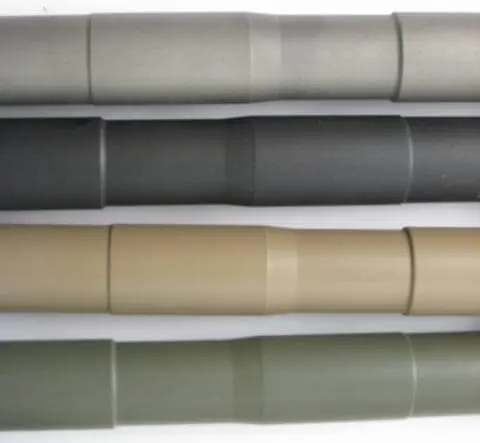
By Wayne Anderson
AR 15 Barrels – Surface Treatments
AR-15 Barrels come in a wide variety of surface treatments – below is a rundown of the major types of treatments, with the pros and cons of each.
This article is part 5 of a 5-part series about AR-15 barrels. The rest of the series can be found at the links below:
Part 1: Intro, Fundamentals, and Manufacturing of AR Barrels
Part 2: Barrel Length, Gas Systems, and Rifling
Part 3: Caliber, Chamber, and Steel Types
Part 4: Profiles, Fluting, and Dimpling
Bare Steel Barrels
Simply put, bare steel is really only appropriate for stainless barrels. CMV steel barrels are not only subject to rust and similar corrosion inside and out, but the hot gases deposit gunk on the inside, and stainless cleans more easily than bare CMV.
Stainless barrels can be had in a few different surface finishes: Polished, satin, or bead blasted. They’re all the same metal, but a polished barrel is pretty close to mirror-smooth and highly reflective. A satin finish is moderately reflective because the surface has microscopic irregularities that diffuse the light. If you want something closer to a flat finish, some shops will blast a barrel with tiny glass beads under high pressure. The result is a flat light silver-grey surface, which doesn’t reflect much at all. It’s not real pretty, but it’s a lot less obvious.
Of the three, a polished finish is the easiest to clean, because there isn’t much on the surface for dirt to cling to. As the finish gets “flatter”, it gets a little harder to clean. Good thing these barrels are stainless because if they were CMV, the microscopic pits are where rust would start.
Blued and “Parkerized” Barrel Treatments
Many civilian guns, especially older ones, have a “blued” finish. This is a chemical treatment to protect carbon steel from rust. You’ll probably never see a blued AR barrel, because the military specified a more robust finish, which is the de facto standard: Manganese phosphate, one of several treatments that fall under the umbrella name of “Parkerizing” (after the Parker Rust-Proof Phosphating Company).
Manganese phosphate is a good finish, very protective and very durable. It’s served military ARs well for over 50 years, and it’ll serve your AR well, too. There’s nothing wrong with it.
Chrome Lining
The current US military rifles aren’t just phosphated. Inside, in the bore, the barrels are given a shiny chrome plating. This process deposits a layer of hard chrome, about 1/10,000th of an inch thick and much harder than the bare steel of the barrel. The chrome lining helps the barrel to resist the extreme heat and stresses of full-auto fire. It also makes it easier to clean, as the vapor deposits don’t have much to cling to on the mirrorlike chrome surface. The downside is that it impacts accuracy slightly. Most expert shooters will tell you that a chrome-lined barrel won’t shoot as well as an otherwise identical barrel without the chrome. But they shoot well enough for most purposes, and they last longer than bare steel.
As we mentioned earlier, some barrels are chrome lined to double thickness, which would be about 1/5000th of an inch. Naturally, that would last longer than regular chrome lining under heavy use, and heavy use is exactly what it’s meant for. The thicker chrome lining will probably affect accuracy a little more than regular chrome lining, but these barrels aren’t for competition target shooting; these are optimized for combat.
Nitride Coating AKA Ferritic Nitrocarburizing
Another type of surface treatment is gaining in popularity: Ferritic nitrocarburizing, also known as black nitride, simply “nitride”, Melonite, Tenifer, QPQ (for “quench/polish/quench”) and a few other names. These processes aren’t necessarily all identical, but in general, they consist of dipping the bare steel in a hot bath of nitrogen salts.
Like Parkerizing, this process produces a chemical change in the surface of the steel, creating a smooth black finish that’s extremely corrosion-resistant. Unlike Parkerizing, it also hardens the steel tremendously and gives it a high lubricity — that is, makes it slick. A nitrided barrel gains interior hardness comparable to a chrome-lined one, without the impact on accuracy, since the process hardens the steel surface instead of depositing another surface over it.
One point to remember about the nitrided barrels: When we say nitrocarburizing hardens the steel, it’s VERY hard — in the neighborhood of 60 HRC (Rockwell scale), about the same hardness as hardened tool steel. That means about the same hardness as drill bits and hacksaw blades. Many gunsmiths refuse to work on nitrided barrels, because the super-hard surface makes it difficult and time-consuming work, so don’t expect them to shorten and thread a barrel or redrill a gas port for you.
Painted AR-15 Barrels
Painting a barrel is one way to customize your rifle or make it look more “tactical,” though it won’t have any real effect on how it shoots. Most barrels will probably take paint well, though some paints might not endure the heat well.
You may need a primer coat, especially if you’re painting polished stainless. A bead blasted stainless barrel offers a much better surface for the paint to adhere to. Some paint companies offer spray cans with ultra flat colors specifically formulated for camouflage use. Like painting the rest of your rifle, most hardware store paints will chip and scratch with use, but that simply helps break up the shape.
Cryogenic Barrel Treatment
One more treatment deserves mention, though, strictly speaking, it’s not a surface treatment. Cryogenic treatment (also called cryogenic quench) is said by proponents to relieve stresses in the steel, improve the microcrystalline steel structure, tighten groups and increase muzzle velocity by about 50 fps.
It involves sending your barrel to one of several commercial processors, usually with a cost of $40-50 and a turnaround time of about a week. These processors will put the barrel through a treatment cycle involving temperatures down to -300F, and sometimes temperatures of several hundred degrees above zero as well, taking up to 72 hours to complete the carefully controlled cycle.
Critics contend that cryogenic treatment has little to no real effect on accuracy. Expert opinion seems to be that it will probably increase barrel life (up to 20%), and won’t hurt the barrel. If a barrel is stress relieved already, the additional stress relief claimed by the processors will probably have a minimal effect. Some manufacturers already have their barrels cryo treated routinely, or offer it as an option in custom orders.
Muzzle Types
Since we’re discussing the barrels themselves, and not actual muzzle devices, there aren’t many alternatives to go over. It basically boils down to a choice between a threaded muzzle or a target crown.
Probably more than 95% of AR barrels these days are sold with muzzle threads. The threaded muzzle is cut a little narrower than the main barrel profile, and screw threads are cut into the last half-inch or so.
On .223/5.56 mm it’s usually 1/2″ x 28 (1/2″ inch diameter by 28 threads per inch). This allows attachment of flash suppressors, compensators, muzzle brakes, sound suppressors, and similar devices, which are discussed in depth in a separate article.
If you want to retain the option of adding muzzle devices but choose for whatever reason not to do so immediately, you’ll probably want to screw on a thread protector – basically, a small cylinder with internal threads that screws onto the threaded tip. This has no real function other than keeping the screw threads undamaged for the day you decide to install a real muzzle device.
The other option is what’s called a target crown, usually found on barrels with no ambitions to ever be combat weapons, such as 24″ varmint barrels. The target crown is much simpler than a flash suppressor, but it’s not a straight cut across the barrel’s end, and it’s not something you’d want to do with a hacksaw in your garage.
When done correctly it’s inset a little at the center, at a carefully chosen angle — say, 11 degrees or so — which provides a bit of protection in case the rifle is accidentally dropped muzzle-down. The machining here should be very precise, consistent all around at the point where the bullet leaves the barrel, because any irregularities will result in gas escaping unevenly. This can push the barrel minutely in one direction or another, or can actually affect the bullet’s flight downrange.
Conclusion
To sum it all up: Like everything else, barrel choice is a matter of personal preference, and varies tremendously with the mission you require of it. If you want to shoot out to the limits of the .223/5.56 family’s effective range, you’ll want a longer barrel to maximize muzzle velocity.
If you want a general-purpose rifle good for everything from a range toy to emergency defense, a 16″ barrel in a lightweight or M4 contour wouldn’t disappoint you. If you’re shooting in a fast, combat-like competition or tactical carbine training, you’ll want something light and easy to handle, but accurate, like a premium M4 style barrel. For bench rest competition, a match-type heavy or bull barrel in stainless is probably your best choice.
One Last Tip
If there’s anyone that knows the AR-15 platform, it’s the US military. As a special offer for our readers, you can get the Official US Army Manual for AR-15/M4/M16 right now – for free. Click here to snag a copy.





Why can’t a muzzle cut for a target crown also be threaded?
Lotsa info. Thanks
This was an outstanding series. I’ve been reading so many “in depth” articles that are SUPER basic, and haven’t learned anything. You have reminded me of things I had forgotten, and taught me some outstanding information I never knew. Please TEACH ME MORE!!! I love it!
Thanks for the great lesson in barrel technology. I always wondered about the different ways barrels were made.
@Tim Otto: The links to the other articles are at the top of the page.
These articles give some good info. I’m new to ARs so this is helpful. I’m not new to guns just ARs. I recently bought a Armalite 5.56MM. Working on mags and ammo now. 😉
I read parts 1, 2, & 5. Where are parts 3 &4?